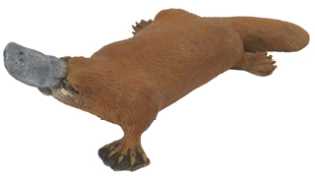
June 25, 2008

In Karl Shuker’s book, Extraordinary Animals Revisited, there is a subsection entitled “The Cryptic Case of the Colorado Platypus.” In actuality, the largest part of those two pages are devoted to a story of a supposed sighting of a platypus off the coast of Alaska.

Unfortunately, the investigation of the case is distracted by how the initial eyewitness labeled and linked what he saw with an exotic known animal’s name. People associate “seen cryptids” with the animal world they know or have seen on television. But, of course, platypuses are Australian, freshwater, and usually no bigger than 20 inches long, not Alaskan, marine, and six feet in length.
Nevertheless, this story has ended up in the “platypus file,” after it first was shared on the Bigfoot email list (on August 7, 1999). It then was posted on Chad Arment’s cryptozoology elist, and finally found its way into Karl Shuker’s chronicling of the encounter. My headline comes out of the overall question of it being called a “platypus,” not by the chroniclers but by the eyewitness. (Things like this happen in investigative skeptical cryptozoology. Items get a tag on them and gather dust in a file cabinet. We brush them off, once in awhile, and make inquiries about them again. New angles develop and new insights are seen.)
Therefore, below is the essence of how Rob Alley recorded the sighting first on that Bigfoot list:
Several years ago Mike F., a successful Ketchikan businessman, contractor and retired fisherman asked me…whether I had ever studied or read anything about platypuses in North America, specifically whether I knew of any prehistoric giant forms….
[Later he told me] that as a young man forty or so years ago he had stood on shore near Mountain Point south of Ketchikan and spent a minute watching an animal in the water at very close range that simply resembled a giant platypus. He described the creature as dark with a bill and feet like a platypus only the overall size was six feet or possibly greater. He gave no mention of the tail if there was one. The sighting was in shallow water on a rocky shoreline and the creature was close to the surface….
The man is an experienced commercial fisherman and stated categorically that it was not a known species of seal.
Ocean temp here doesn’t vary much from 50 degrees.
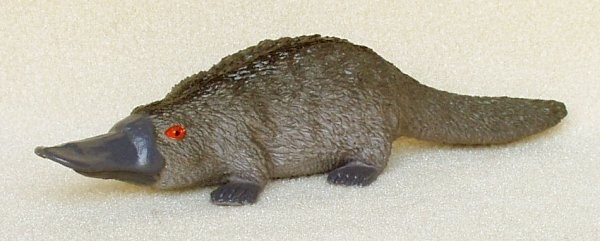
The investigator who interviewed the eyewitness is J. Robert Alley, the author of the 2003 book, Raincoast Sasquatch: The Bigfoot / Sasquatch Records of Southeast Alaska, Coastal British Columbia & Northwest Washington from Puget Sound to Yakutat. It is logical that Alley would be told such a story, considering the fact he is a lightning rod for cryptid sightings in Alaska.
(Ignore that the account is repeated at the end of Shuker’s subsection in summary, as if what is there is a different sighting. Overlook that a small mention of an alleged Colorado platypus incident leads off a paragraph and merges into the Alaskan case. And don’t pay attention to Shuker’s question about “where, precisely” did the “Mike F.” sighting occur, even though the account clearly says where it happened. Shuker told me recently those are just clerical, editing errors.)
The story contains the location of the Alaskan origins of this sighting. The city of Ketchikan is noted, and that’s a coastal location in Alaska, on a marine inlet that opens to the Gulf of Alaska. The specific location noted for the sighting, Mountain Point, is 6 miles south of Ketchikan, Alaska, and is today a well-known clear water snorkeling area off Alaska. This is an ocean sighting.
Could this cryptid be a turned around, misidentified pinniped, perhaps a sea-elephant, which makes more sense than a platypus? Perhaps it is something simpler?
No, says the eyewitness, “categorically…it was not a known species of seal.”
Does anyone have any experience with an animal off the coast of Alaska that could have been confused with a “six foot long platypus”?
Cryptozoology artist RobRoy Menzies of Alaska emails me this: “I would guess somebody saw a sea lion with a halibut in its mouth. I have experienced catching halibut only to watch sea lions tear it up and swim off with it!”
Suggested by Dave Pelley:
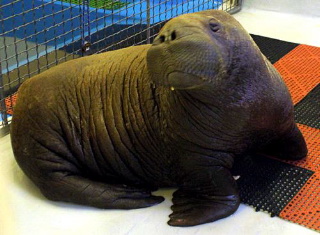
Suggested by Red Pill, pointed to by David Fullam:
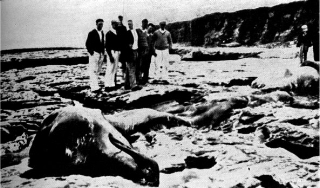
San Cruz remains of a Baird’s Beaked Whale.
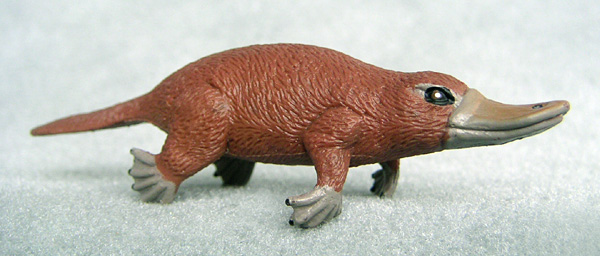
A bizarre footnote to this story is that the Latin name for the Alaskan blue king crab is Paralithodes platypus.
^^^^
Credit for the bottom images of platypuses are taken from the collection of the Tapir Preservation Fund.
The one at the top is a Wild Safari replica from Safari Ltd.
About Loren Coleman
Loren Coleman is one of the world’s leading cryptozoologists, some say “the” leading living cryptozoologist. Certainly, he is acknowledged as the current living American researcher and writer who has most popularized cryptozoology in the late 20th and early 21st centuries.
Starting his fieldwork and investigations in 1960, after traveling and trekking extensively in pursuit of cryptozoological mysteries, Coleman began writing to share his experiences in 1969. An honorary member of Ivan T. Sanderson’s Society for the Investigation of the Unexplained in the 1970s, Coleman has been bestowed with similar honorary memberships of the North Idaho College Cryptozoology Club in 1983, and in subsequent years, that of the British Columbia Scientific Cryptozoology Club, CryptoSafari International, and other international organizations. He was also a Life Member and Benefactor of the International Society of Cryptozoology (now-defunct).
Loren Coleman’s daily blog, as a member of the Cryptomundo Team, served as an ongoing avenue of communication for the ever-growing body of cryptozoo news from 2005 through 2013. He returned as an infrequent contributor beginning Halloween week of 2015.
Coleman is the founder in 2003, and current director of the International Cryptozoology Museum in Portland, Maine.
Filed under Breaking News, Cryptomundo Exclusive, Cryptotourism, CryptoZoo News, Cryptozoologists, Cryptozoology, Eyewitness Accounts, Megafauna, Replica Cryptia, Sea Serpents, Weird Animal News